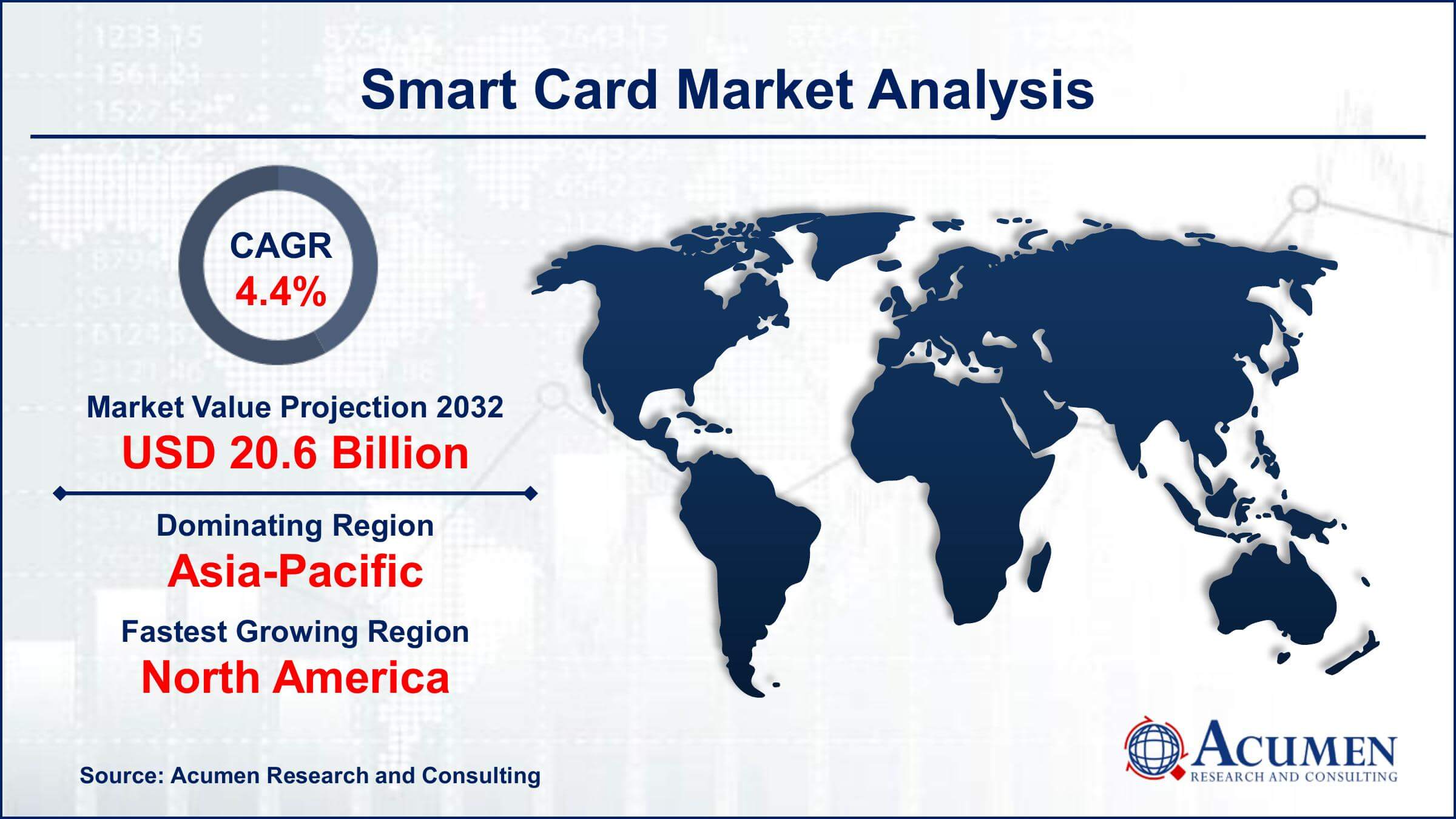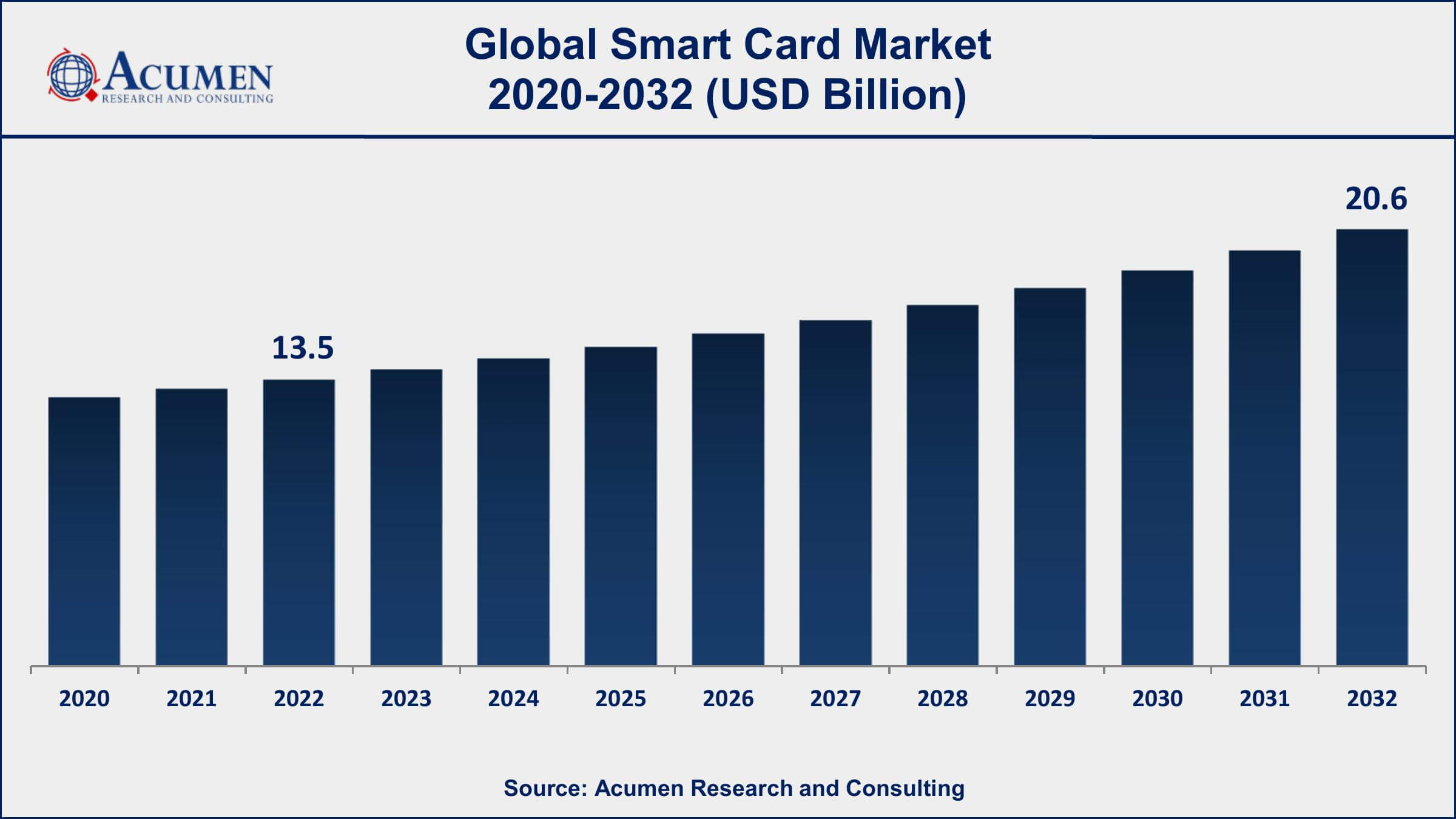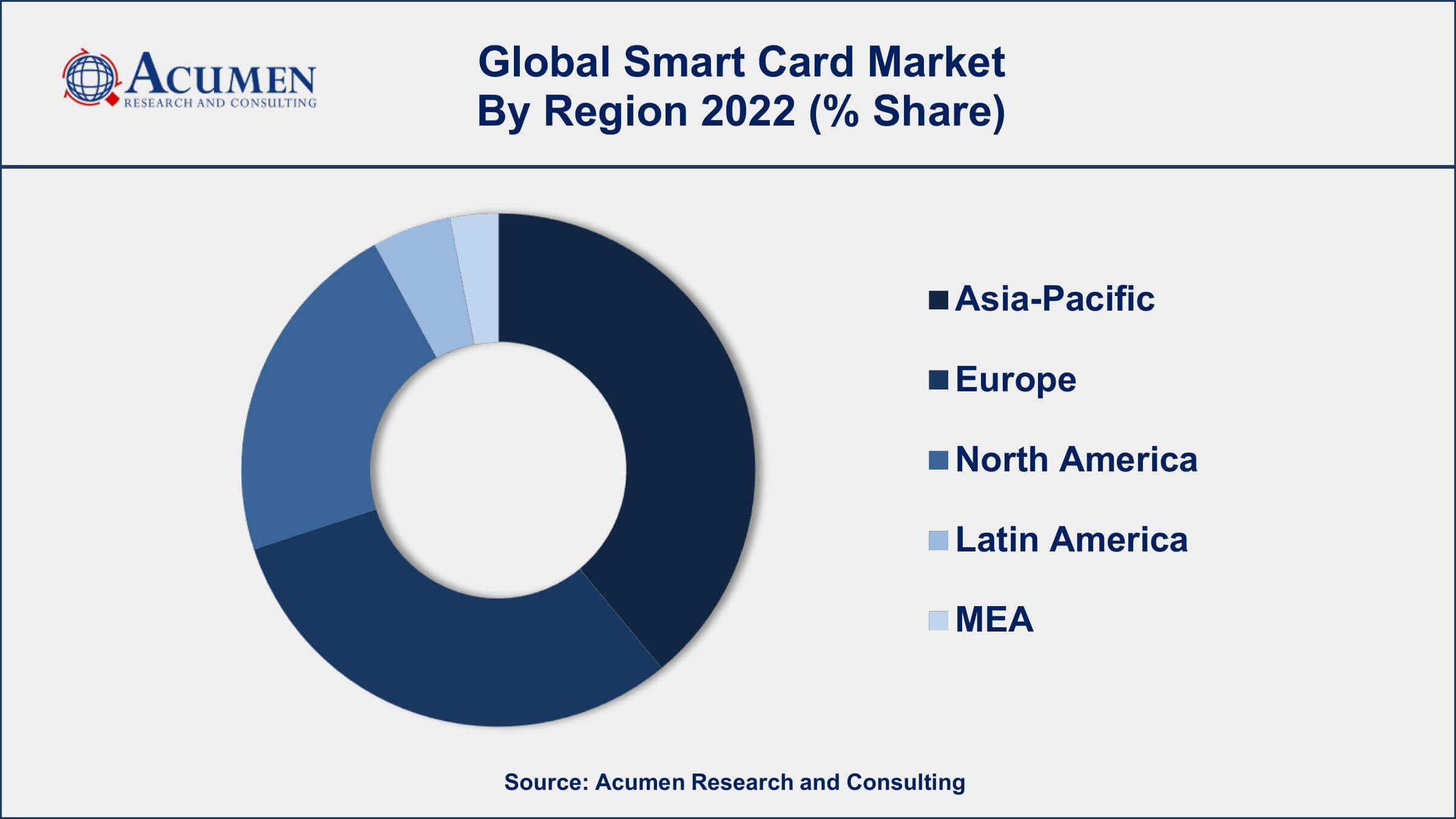Smart Card Market Size - Global Industry, Share, Analysis, Trends and Forecast 2023 - 2032
Published :
Report ID:
Pages :
Format :
Smart Card Market Size - Global Industry, Share, Analysis, Trends and Forecast 2023 - 2032
Report Coverage
- Industry Dynamics
- Market Size and Forecast Data
- Segment Analysis
- Competitive Landscape
- Regional Analysis with a Niche Focus on Country-Level Data
- High Level Analysis - Porter's, PESTEL, Value Chain, etc.
- Company Profiles of Key Players
- Option to Customize the Report As Per Your Specific Need
Request Sample Report
The Global Smart Card Market size accounted for USD 13.5 Billion in 2022 and is projected to achieve a market size of USD 20.6 Billion by 2032 growing at a CAGR of 4.4% from 2023 to 2032.
Smart Card Market Report Key Highlights
- Global smart card market revenue is expected to increase by USD 20.6 Billion by 2032, with a 4.4% CAGR from 2023 to 2032
- Asia-Pacific region led with more than 39% of Smart Card market share in 2022
- Smart cards are increasingly being used for identity verification in various industries. For Instance, in India, the government has issued smart cards to citizens that include their biometric information, which is used for authentication when accessing government services
- Smart Card provides a higher level of security compared to traditional magnetic stripe cards because the data is stored in an encrypted form on the chip
- Among applications, the telecommunication sub-segment generated more than 30% share in 2022
- Increasing demand for contactless payment methods, drives the Smart Card market size

A smart card is a small plastic card with a computer chip embedded inside. The chip contains data that can be read and processed by a smart card reader. Smart cards are used for a variety of applications, including payment processing, identification, access control, and loyalty programs. They offer a higher level of security compared to traditional magnetic stripe cards because the data is stored in an encrypted form on the chip. Smart cards can also be used for contactless payments, which speeds up the payment process and reduces the time spent waiting in lines. They are becoming increasingly popular in a variety of industries due to their convenience, efficiency, and security benefits.
The market for smart card has been growing steadily over the past few years. This growth can be attributed to several factors, including increased demand of contactless payment methods, advancements in smart card technology that have improved their performance, security and accuracy, and the growing demand for smart card in healthcare industry. Additionally, the COVID-19 pandemic has led to an increase in usage of contactless cards to reduce the transmission of virus, which increased the overall demand of smart card.

Global Smart Card Market Trends
Market Drivers
- Increasing demand for secure payment systems
- Growing adoption of contactless payment technology
- Government regulations and incentives promoting the use of smart cards
- Increasing use of smart cards in healthcare
- Technological advancements in smart card systems
Market Restraints
- Limited functionality of smart cards
- High cost of smart card production
- Security concerns due to improper usage
Market Opportunities
- Integration with other technologies such as biometric integration
- Growing adoption of IoT devices
Smart Card Market Report Coverage
| Market | Smart Card Market |
| Smart Card Market Size 2022 | USD 13.5 Billion |
| Smart Card Market Forecast 2032 | USD 20.6 Billion |
| Smart Card Market CAGR During 2023 - 2032 | 4.4% |
| Smart Card Market Analysis Period | 2020 - 2032 |
| Smart Card Market Base Year | 2022 |
| Smart Card Market Forecast Data | 2023 - 2032 |
| Segments Covered | By Product, By Application, And By Geography |
| Regional Scope | North America, Europe, Asia Pacific, Latin America, and Middle East & Africa |
| Key Companies Profiled | Infineon Technologies AG, Bartronics India Limited, Perfect Plastic Printing, Valid, CardCom, Identiv Inc., Brilliant TS, ABCorp, Eastcompeace Technology Co. Ltd., Austria GmbH Styria, Thales, HID Global Corporation, Infineon Technologies AG, IDEMIA, NXP, and Kona. |
| Report Coverage |
Market Trends, Drivers, Restraints, Competitive Analysis, Player Profiling, Covid-19 Analysis, Regulation Analysis |
The growing demand for contactless payment systems due to their convenience, speed, and safety is contributing a major revenue share to the market. Since the 1995s, the smart cards are widely used as sim cards by telecommunication industry. SIM cards have traditionally been removable and interchangeable between devices, allowing users to easily switch devices and service providers. Smart cards can be used as SIM cards in various applications, such as in the Internet of Things (IoT) devices or in machines that require connectivity. In these cases, the smart card acts as a secure identification and authentication tool, enabling secure communication between devices and networks.
There has been increase in the adoption of smart cards in healthcare systems. Smart cards are widely used to store patient information and medical records. This recorded information can be accessed anytime anywhere by the personnel. This trend is expected to drive the growth of the smart card market in the healthcare industry.
Traditionally, smart cards are utilized as a payment method, for example, debit cards, credit cards, etc. This allows customers to make transactions without physically touching a payment terminal or handing over cash or cards. Instead, contactless payments rely on Near Field Communication (NFC) technology, which enables two devices to exchange data wirelessly when they are close to each other.
Governments in many countries are mandating the adoption of contactless payment systems, as they are seen as a more secure and efficient payment method.
Regardless of its numerous benefits, the market may witness negative growth affected by high production cost, limited awareness, and limited functionality. Nonetheless, technological advancements have facilitated improvement in the applications of smart cards, which will propel the market growth in the coming years. Furthermore, the smart card market is becoming increasingly competitive, with many players entering the market with new and innovative products. This competition is driving the development of new products and technologies, which is expected to benefit consumers.
Smart Card Market Segmentation
The global smart card market segmentation is based on product, application, and geography.
Smart Card Market By Product
- Contact Cards
- Contactless Cards
- Hybrid Cards
- Others
According to the Smart Card industry analysis, the contactless cards segment is predicted to lead the market. Contactless cards are a type of smart card that allows users to make payments without having to physically insert or swipe their card. Instead, contactless cards use near field communication (NFC) technology to communicate wirelessly with a payment terminal when the card is held close to the terminal. Contactless cards are commonly used in various industries, including retail, transportation, hospitality, and healthcare. As the demand for contactless payments continues to grow, the use of contactless cards is also expected to increase, which will drive the growth of the smart card market. Hybrid cards will have a significant market share and will help in boosting the growth of smart cards in the market.
Smart Card Market By Application
- BFSI
- Government & Security Systems
- Transportation
- Telecommunication
- School
- Healthcare
- Others

In terms of application, the telecommunication segment is accounted the largest market share in 2022. Smart Card are widely used as a means of identifying and authenticating their subscribers, allowing them to access various services such as making calls, sending text messages, and accessing data networks. In addition to providing secure access, smart cards also offer several other benefits for telecommunication providers. They can be used to manage subscriber information, including billing and usage data, enabling companies to offer personalized services and pricing plans. Smart cards can also be used to control access to premium services, ensuring that only authorized users can access these services. The use of Smart Card in BFSI segment has been growing rapidly in recent years, driven by increasing demand for contactless payment methods (tap-and-pay).
Smart Card Market Regional Outlook
North America
- U.S.
- Canada
Europe
- U.K.
- Germany
- France
- Spain
- Rest of Europe
Asia-Pacific
- India
- Japan
- China
- Australia
- South Korea
- Rest of Asia-Pacific
Latin America
- Brazil
- Mexico
- Rest of Latin America
The Middle East & Africa
- South Africa
- GCC Countries
- Rest of the Middle East & Africa (ME&A)

Smart Card Market Regional Analysis
The Asia-Pacific region dominates the Smart Card market due to several factors. One of the primary drivers is the increasing demand for contactless payment method in the region, particularly in countries such as China, Japan, South Korea, and India. The region experiences high levels of technological advancements, and the use of Smart Card can significantly improve the usage of contactless cards for payments and to enhance the safety and security while performing a transaction. As a result, there is a growing adoption of smart cards in multiple applications, like BFSI, healthcare, etc. across the region.
Another factor contributing to the dominance of the Asia-Pacific region in the Smart Card market is the presence of several leading manufacturers in the region. These manufacturers are investing heavily in research and development activities to develop advanced smart cards that can meet the specific needs and requirements of the Asian market. Additionally, the availability of raw materials and skilled labor at lower costs in the region has further boosted the growth of the market.
Smart Card Market Player
Some of the top Smart Card market companies offered in the professional report include Infineon Technologies AG, Perfect Plastic Printing, Austria GmbH Styria, CardCom, Identiv Inc., HID Global Corporation, Brilliant TS, ABCorp, Bartronics India Limited, Eastcompeace Technology Co. Ltd., Thales, Infineon Technologies AG, IDEMIA, NXP, and Kona.
Frequently Asked Questions
What was the market size of the global Smart Cardin 2022?
The market size of Smart Card was USD 13.5 Billion in 2022.
What is the CAGR of the global Smart Card market during forecast period of 2023 to 2032?
The CAGR of Smart Card market is 4.4% during the analysis period of 2023 to 2032.
Which are the key players operating in the market?
The key players operating in the global Smart Card market are Infineon Technologies AG, Bartronics India Limited, Perfect Plastic Printing, Valid, CardCom, Identiv Inc., Brilliant TS, ABCorp, Eastcompeace Technology Co. Ltd., Austria GmbH Styria, Thales, HID Global Corporation, Infineon Technologies AG, IDEMIA, NXP, and Kona.
Which region held the dominating position in the global Smart Card market?
Asia-Pacific held the dominating position in Smart Card market during the analysis period of 2023 to 2032.
Which region registered the fastest growing CAGR for the forecast period of 2023 to 2032?
North America region exhibited fastest growing CAGR for Smart Card market during the analysis period of 2023 to 2032.
What are the current trends and dynamics in the global Smart Card market?
The current trends and dynamics in the Smart Card industry include the growing demand for contactless payment methods, and increasing use of Smart Cards in BFSI industry.
Which application held the maximum share in 2022?
The telecommunication application held the maximum share of the Smart Card market.




